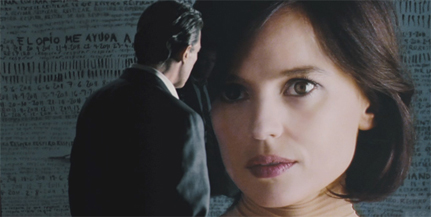|
|
Movie Review: The Skin I Live InBy Matthew HuntleyOctober 26, 2011
The first occurs when Robert’s half-brother, Zeca (Roberto Álamo), wanted for bank robbery and dressed in a tiger costume, shows up and sees Vera. An ugly incident ensues before the film delves into the histories of its two main characters. It transports us six years into the past when Robert was married and had a daughter. Eventually, separate tragedies will leave him grief-stricken and alone. In a related subplot, we meet Vicente (Jan Cornet), a twentysomething mamma’s boy who works in his mother’s dress shop. He puts the moves on his lesbian co-worker, to no avail, before meeting Robert’s daughter, Norma (Blanca Suárez), at a wedding. Norma, still traumatized over her mother’s death, takes a walk with Vicente and he tries to have sex with her in the woods. What happens next is not exactly rape, but it’s also not consensual sex, either. The encounter worsens Norma’s sociopathic condition and Robert has no choice but to commit her to a mental hospital. It also leaves Robert vengeful toward Vicente. More about the plot, I cannot say, except that all the characters and stories intertwine in ways that are probably unbelievable on paper but completely reasonable in the film. Even if I did reveal its secrets, The Skin I Live In is a rich experience beyond its narrative. On a production level, it’s one of best looking films of the year, composed of grandiose wide shots and detailed close-ups. Almodóvar’s longtime cinematographer, José Luis Alcaine, and production designer, Antxón Gómez, work together to create a multi-layered world where there’s almost always something interesting in frame. And the way Almodóvar films the action, either by holding on the characters as they walk from one end of the hallway to the other, or by having them slowly put on latex gloves, is strangely infectious and mesmerizing. These shots don’t just advance the scenes; they show the characters in their element. There are other striking shots in the film, especially of Robert’s mansion, where he displays several paintings of human beings. Almodóvar contrasts the beauteous, artistic surroundings with the characters’ dark, inner turmoil, building on the theme that things on the outside sometimes have no bearing on the way we feel inside. Working from the novel Tarantula by Thierry Jonquet, Almodóvar, makes us realize emotions are malleable and can either change over time or instantly and they’re not always decipherable. When viewed from a traditional point of view, with our usual, generic expectations in place, The Skin I Live In is weird and twisted, but once we realize it’s a film that goes out of its way to be bereft of things that are traditional and usual, it envelops us in a way few films do. It makes weird and twisted seem normal and challenges us to think outside our comfort zone. By the end, we see how emotions like anger, vengeance, lust and love can arise from the most unexpected places. It’s these places the film is willing to go.
|

|
|
|

|
Thursday, October 31, 2024
© 2024 Box Office Prophets, a division of One Of Us, Inc.


